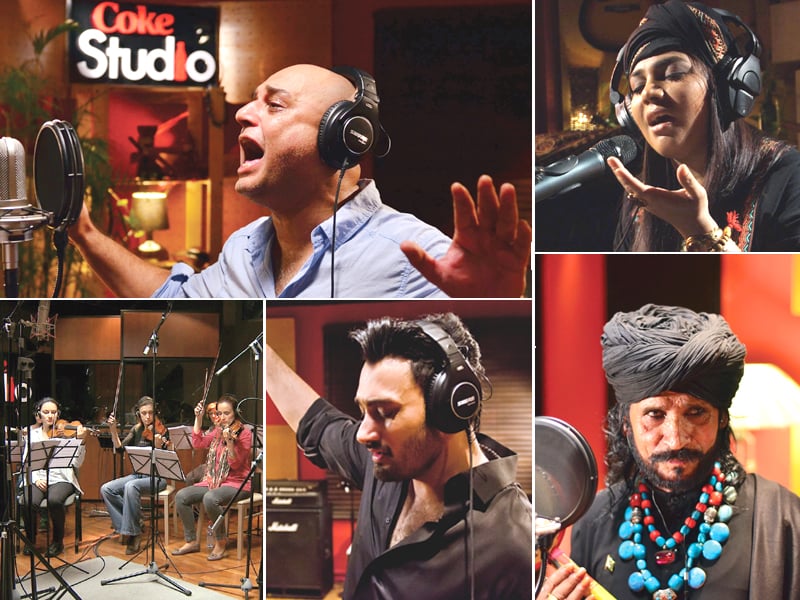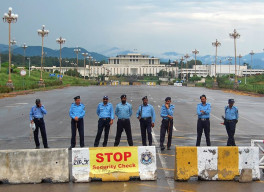
The much-awaited first episode of Coke Studio season 6 aired on Sunday evening after singles Jogi and Laili Jaan were released last week. The platform has a new look and feel; red, white and black have given way to a more organic set and earthy ambience. Moreover, the house band does not feature as a collective unit anymore. Instead, a number of international musicians and groups are recorded in their native countries, while artistes from Pakistan record tracks separately. Because the show is shot in different parts of the world and captures musicians in their natural environment, the visuals are a refreshing change from the earlier slightly bleached footage of musicians holed up on raised platforms behind sound screens.
Some musicians are not recorded in a studio at all. Muhammed Asifur Rehman from Bangladesh, for example, is recorded playing his do tara sitting on a balcony overlooking a scenic view of the lush green hills of Chittagong for Saeen Zahoor’s Rabba Ho.
Very few could have predicted the potential impact of Coke Studio when it was launched in 2006. The show quickly became the biggest export product of the Pakistani music industry, causing even our neighbours to take notice and launch their own Indian version with Coke Studio @ MTV. Not only did our platform set a new benchmark for audio-video production, but it was also the first real attempt at blending contemporary, classical and folk music to create fusion of sound. By putting Saeen Zahoor and Arif Lohar on stage, Coke Studio appealed to young viewers, who may have dismissed these artistes as being ‘raw’ and ‘less exciting’ on their own. Its focus on experiment is also enhanced by the inclusion of pop artistes Noori, Meesha Shafi and Strings, who played with sound and recreated songs under the influence of Eastern music.
But while it has been the harbinger of sound innovation, by its fifth season in Pakistan, Coke Studio seemed to have exhausted its fountain of creativity as tracks were beginning to sound too monotonous. At the same time, its Indian counterpart was exploring new avenues of music production and pushing the limits of a format that we had pioneered in.
This was enough to push Rohail Hyatt out of his comfort zone. With new musicians, fresh sounds and flashes of brilliance, its sixth season tells us Coke Studio is here to stay and Rohail Hyatt’s bag of tricks may just treat us. Below is our verdict on the first episode:
Khayaal by Umair Jaswal
Though it is heartening to see a rock vocalist in a mainstream project such as Coke Studio, the raw emotion is too heavily veiled under the grand, orchestral sound that Jaswal and Hyatt are seen discussing in the BTS footage. There is no arguing that Jaswal has the ability to deliver a trailblazing performance but his vocal ability is camouflaged by a rich sonic layer of a string section and reverb-drenched guitars. If Jaswal is to accomplish his dream of reviving rock music in Pakistan, he will have to be less apologetic about it.
Babu Bhai by Ali Azmat
The number is a breath of fresh air for the show and in this track, Ali Azmat proves that he is Pakistan’s biggest rock star — unafraid of innovation and completely self-absorbed. Babu Bhai is simple yet effective. A tight groove with just the right amount of swing coupled with electronic sampling, makes this song a fitting choice for someone who Hyatt describes to the Serbian musicians as “a funny guy.”
Rabba Ho by Saeen Zahoor ft Sanam Marvi
This is what Coke Studio has done successfully in the past — fusing the rawness of folk music with the finesse of modern audio production in a way that it synchronises well with both the young and the old — the contemporary and the traditional. Needless to say, Saeen Zahoor is his usual eclectic-self and Sanam Marvi lends strong support.
The song features a wide range of instruments played from different parts of the globe, including Italy, Bangladesh, Nepal and Morocco, and exhibits great musicianship. One noteworthy mention would be the sarangi solo by Kiran Nepali from Nepal.
Published in The Express Tribune, October 29th, 2013.
Like Life & Style on Facebook, follow @ETLifeandStyle on Twitter for the latest in fashion, gossip and entertainment.
COMMENTS (18)
Comments are moderated and generally will be posted if they are on-topic and not abusive.
For more information, please see our Comments FAQ


1731975305-0/Untitled-design-(40)1731975305-0-165x106.webp)
1731975060-0/Untitled-design-(39)1731975060-0-165x106.webp)






1731929357-0/Express-Tribune-(6)1731929357-0-270x192.webp)






So what happened to Episode #2? It feels like torture this year, no information about anything.
Coke Studio Pakistan is a terrific product. While a few Pakistanis criticize India for copying the format, they take care to hide the fact that the pioneers of Coke Studio are the Brazilians.
this season is really different. it's amazing
I have always got some sort of EXCITEMENT for Coke Studio, but only few of the tracks manage to cope with that EXCITEMENT. anyhow, this time its quite different n I miss the house band like others do. saeen zahoor n sanam marvi's track is a good collaboration but I think something of an over has been done when it comes to the end of the kalam (I m talking about the music). Even with all this I love Coke Studio and would never want it to end EVER:)
Coke studio 6 really exellent,specially the fusion of folk n clasic touches not only our hearts but our souls too.really have no words but we can compete n stand through coke studio any where in the world.
Missing the house band. But you're right, it's still early days, let's see what RH has in store for us.
Ali Azmat needs to stop with his inefficient use of falsettos in his songs. He has developed this style of singing and it is horrible i think. That shriek that comes out of his voice at the start of every word is unbearable and doesnt sound nice. Pick up his old Junoon songs and you will see the difference.
Sorry, coke studio has lost its fizzle. It does sound monotonous and the house band is being missed by all. Where is Gumby, Asad Ahmed, etc? Bringing in international artists is innovative and they are welcome but the beauty of original coke studio was in the display of raw Pakistani talent. This season, artists look like they are just going through the motions to get the job done. Passion is not there as it was in the first 3 seasons. No doubt Rohail is a music genius but I think he may be trying a little too much in this season. Should keep it simple and raw - he is an awesome producer and guide - let the artists do the rest with his guidance.
I liked the coke studio arabia, they should mix it with english singers/songs. and make it upbeat more lively. Kudos to Rohail though, we know he's good!
Coke Studio did not start in Pakistan in 2006, in fact it started in Year 2008.
i hope this season is a good one... apart from music they should focus on bringing in good singers and tracks too.. im astonished y rahat never brought again, instead atif was exhausted.. also other good and diverse singers should be tested..pashto, urdu and punjabi songs should be combined...
Some how it doesn't feel like a "studio" any more. Saeen Zahoor and Marvi can sing in any setting, but Coke Studio brought everyone together and one felt a part of the performance. One misses that.
Agree with this review!! I hope both the Nepali, Bangladeshi musicians as well as the drummer from Laili Jan are invited to play along with the house band. That would be exciting to watch. :D
Chalta hai.............its got stuck in a groove. I would say monotonous describes the sound.
though they have made changes in the format which are being praised,but still I miss the house band!
missing house band though! hope to see them together at some point.